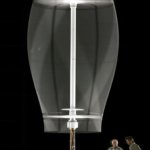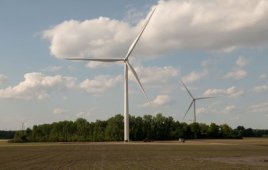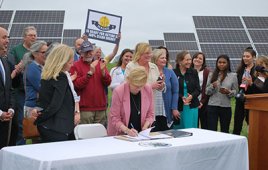
The S-shaped blades are tapered to shed noise. The helical design captures turbulent winds and eliminates vibration. The blades, spars, and torque tube are made of durable carbon fiber and all moving parts are sealed to minimize maintenance. The direct drive inline generator has built in auto shutdown and peak power tracking.
One forecast for small scale wind generators (sometimes called microgeneration) has them providing 30 to 40% of all the UK’s electricity needs by 2050. The British Wind Energy Association hints that with price trends for crude oil continuing up, the cost of small scale wind could be competitive with fossil fuels by as early as 2010.
Although the UK has excellent wind resources, where the turbine is located is still crucial to the output expected from it. Ideally, a wind turbine would have no obstructions between it and the prevailing wind direction.
In an urban or built-up environment, some wind turbulence is inevitable unless the turbine is sited well above any surrounding buildings. Most of the time, turbulence from surrounding buildings will affect a wind turbine to some extent. This is the primary reason for opting for a vertical-axis wind turbine, because the design doesn’t require wind from a consistent direction to produce power. A horizontal axis wind turbine, on the other hand, has to physically rotate into the wind every time the direction changes.
U.K.-based quietrevolution says its 5-kW helical design ensures good performance even in turbulent winds. It is also responsible for almost eliminating noise and vibration. At five meters high and three meters diameter, it is compact and easy to integrate. And with just one moving part, maintenance can be limited to an annual inspection. The table includes a few specs:
Filed Under: Uncategorized





There is no useful wind resource at the rooftop level in cities. Turbulence is a problem for sure but not as big a problem as the lack of energy. Quiet revolution have only been independently assessed once that I know of and the net energy was negative due to inverter losses.
You make a very good point. Compare with this DOE sight for average costs per kwh by state and sector, http://www.eia.doe.gov/cneaf/electricity/epm/table5_6_a.html. Note cents/hr vs. dollars/hr. However, the point of \Small Wind Turbines\ is not necessarily cost efficiency. Larger systems will always out perform smaller systems in terms of efficiency, but on a rural stage where it costs tens of thousands of dollars to join the grid, small turbines might be the answer.
Vertical Axis / Urban Turbines may “work well’ depending on how that is defined. These turbines will not, however, produce energy for an affordable rate – with or without subsidies.
Check out the verticals that are listed on this site:
http://www.small-wind-turbine.com
Lower $/RAE is better.